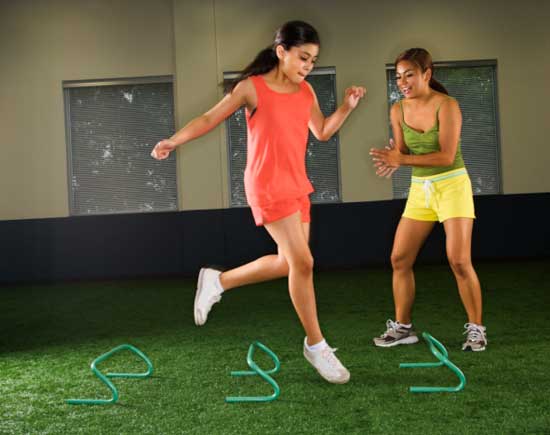
There is no doubt about it—kids need to exercise to stay healthy and grow strong. Children who engage regularly in physical activity tend to do better in school, and a growing body of evidence suggests that health-related behaviors acquired during childhood and adolescence are more likely to be continued into adulthood. Therefore, a youngster who enjoys physical activity and learns how to live a physically active life is more likely to become an active adult.
Given the dramatic cutbacks in school-based physical education programs, many parents are turning to fitness professionals to help their kids get the recommended amount of exercise. Yet unlike adults, most kids are not interested in organized or supervised exercise programs, and research suggests that the recommended exercise protocol for getting adults in shape is not particularly effective or enjoyable for preadolescents. Children prefer activities that are typically considered free play or are organized like games. So rather than focus entirely on fitness skills and sports performance, youth programs should be geared toward fostering lifelong physical activity habits. When planning an exercise program for children, always keep the fun factor high and consider the following guidelines for teaching and motivating children to exercise:
1. Outline clear training objectives. If you are organizing a regular routine workout with children, set clear training objectives in a simple-to-understand manner. Provide a copy of these guidelines for their parents as well.
2. Use concise instruction with precise demonstration. Show and tell is a simple but effective way to communicate how to perform an exercise.
3. Provide attentive supervision. Many children lack confidence in their exercise abilities and need extra attention and encouragement. Never step out of the room or divert your attention while kids are exercising.
4. Provide appropriate assistance. Strength training is often difficult for young exercisers. Provide a little manual assistance to guide them to a successful exercise experience.
5. Perform one task at a time. Give children only one task at a time to ensure they do not become confused. This increases the probability they will progress successfully through the exercise session.
6. Gradually progress. Take small steps with young exercisers. Do not introduce a new task until the first one is mastered. Better to have young exercisers learn the correct way to exercise than to un-learn the wrong way.
7. Provide lots of positive reinforcement. Increase a child’s self-confidence and satisfaction with exercise by giving them encouraging comments, personal compliments or a pat on the shoulder. Telling children they are doing a good job is one of the best ways to keep them doing a good job.
8. Offer specific feedback. Positive reinforcement is much more meaningful when delivered with specific feedback. Giving a reason for your comment increases the value of the statement.
9. Word questions carefully. Children may be reluctant to offer information that could be useful in selecting the right exercises. Try to ask questions that require more than a yes or no answer.
10. Keep the lines of communication open. Spend some time before and after an exercise session in an enthusiastic conversation with the children. It will give you insight into what makes them tick.
For more information on designing exercise and strength-training programs for kids, check out Youth Fitness and Youth Strength Training, by Avery Faigenbaum, Ed.D., and Wayne Westcott, Ph.D., available at www.acefitness.org/store.
Additional Resources
Faigenbaum, A., and Westcott, W. (2001). Youth Fitness http://www.acefitness.org/acestore/p-295-youth-fitness-aces-group-fitness-specialty-series.aspx
Faigenbaum, A., and Westcott, W. (2005). Youth Strength Training http://www.acefitness.org/acestore/p-269-youth-strength-training.aspx
ACE Fit Facts: Ten Fun Fitness Summer Activities for Kids http://www.acefitness.org/fitfacts/fitfacts_display.aspx?itemid=2684
ACE Youth Fitness CEC Courses